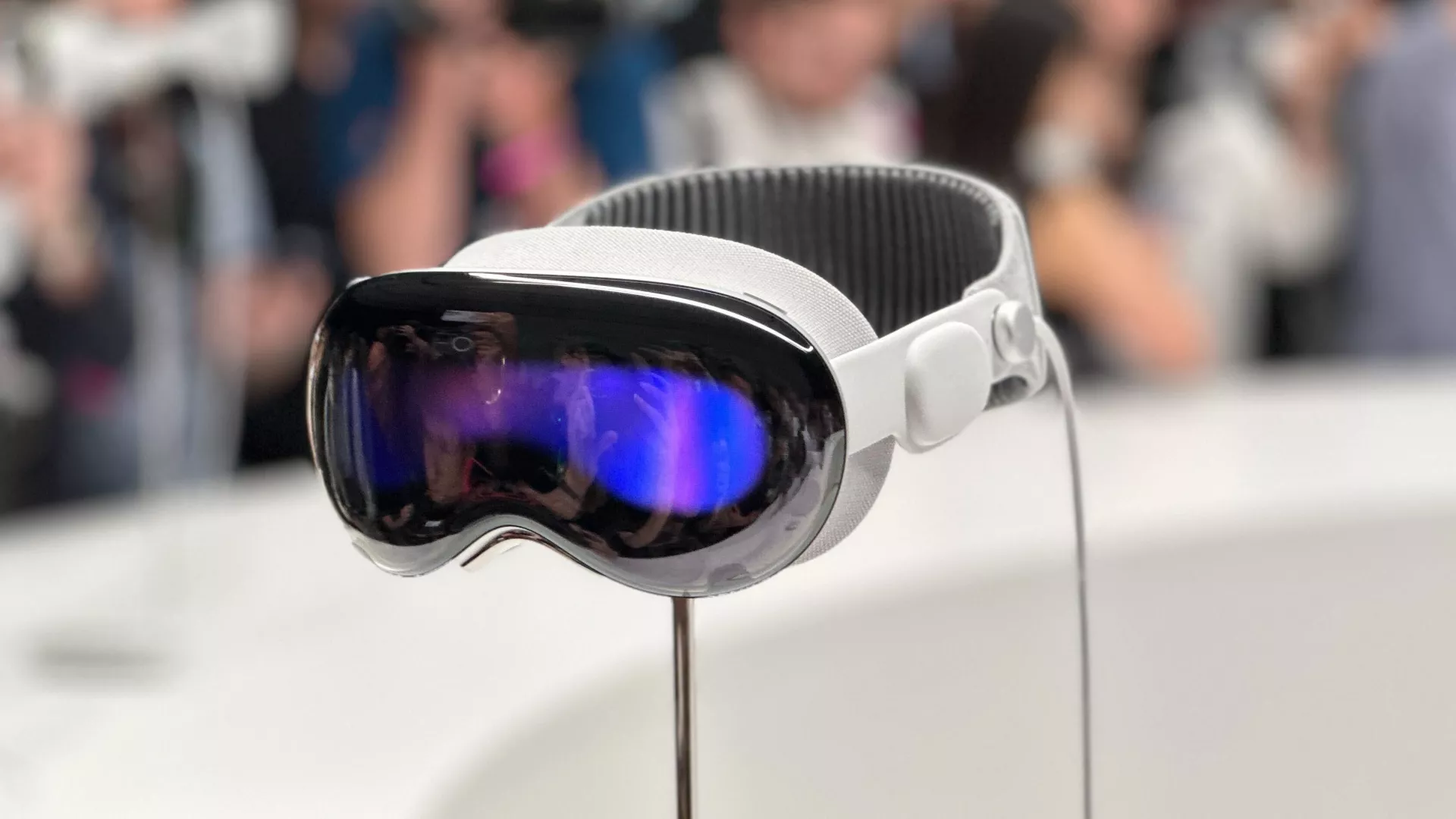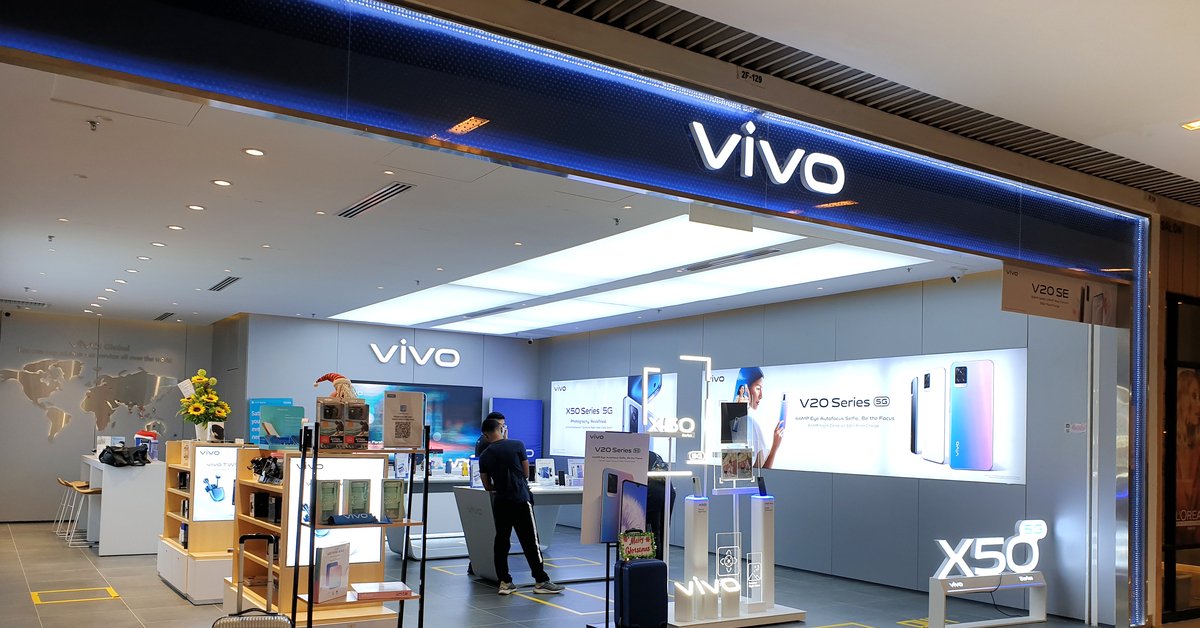Apple’s first mixed reality headset is finally here and it’s not cheap
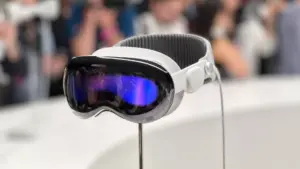
The Apple Vision Pro is Apple’s first official mixed reality headset. And you can see our first impressions in our Apple Vision Pro hands-on review.
And let’s be clear — when we say mixed reality, we mean it. While the headset may look like a contender for the best VR headset on the market, it is not designed to keep you immersed in a virtual world. Features such as EyeSight and Digital Persona ensure that not only are you still engaged with the physical world, but the physical world remains able to engage with you.
But, of course, these groundbreaking features come with an earth-shattering price. At $3,499, the Apple Vision Pro is easily the most expensive mainstream headset — virtual reality or mixed reality. And unfortunately, you’ll have to wait a while to get your hands on it, since Apple says it won’t be available until 2024.
Apple Vision Pro: What you need to know
- $3,499 U.S. price. U.S. only starting in early 2024, with availability in other countries to follow.
- Twin 4K displays inside the headset provide incredible HDR picture quality, but if you wear glasses you’ll need to get custom ZEISS inserts.
- EyeSight uses a front display to show others that you are engaging with them or that you are immersed in the headset.
- visionOS allows for 3D experiences native to the Vision Pro. iOS and iPadOS apps will be available in a Vision Pro App Store along with visionOS apps.
- The crown on the top of the headset allows you to control how immersed in the headset you are, from augmented reality to virtual reality.
- No controllers needed — the headset relies on eye and hand tracking in addition to voice commands.
- Take spatial photos and videos with just the tap of a button. EyeSight will let others around you know that you’re taking a photo or video.
- Disney is an official partner with the Vision Pro and is creating exclusive experiences for the headset, including Disney World, Marvel games and more.
Apple Vision Pro price
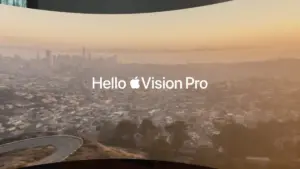
According to Apple’s launch presentation during the WWDC keynote, the Vision Pro will cost $3,499 at launch. The headset will initially be available in the U.S. only, so we do not have pricing for other countries at this time.
Interestingly, one leaker claims Apple only spends $1,509 for each headset it builds. That would be quite a profit margin if true.
While the Vision Pro headset can’t be pre-ordered right now, you can sign up for a notification from Apple so you can be alerted to when the headset will be available to pre-order. With such a high price tag (more on that below) don’t expect the Vision Pro to be shipped en masse.
Apple Vision Pro release date
Apple Vision Pro still doesn’t have an official release date, but it does have an official release date window. Apple says that the headset will become available for purchase in early 2024, which tracks with a rumor we saw just before launch that the headset could get pushed into next year.
As previously mentioned, at its release the Vision Pro will only be available to U.S. customers, though other countries are expected to get a rollout not too long after the U.S. launch.
Apple Vision Pro design
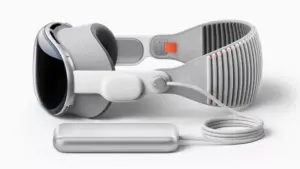
At first glance, the Apple Vision Pro doesn’t look incredibly dissimilar from a traditional VR headset or even a mixed reality device like the Meta Quest Pro. But once you turn it on, there are some distinct differences.
The biggest one is that the front of the visor features a display underneath a curved pane of 3D laminated glass. This allows the Vision Pro to use EyeSight, a feature that shows others around you your eyes so they feel like they’re interacting with you like they would normally.
This glass pane also serves as a lens for the Vision Pro’s camera array, which is extensive. The Vision Pro includes 12 cameras and six microphones so that users do not need controllers to control the device. Instead, you will use a combination of eye tracking, hand gestures and voice commands.
But the front display isn’t all that is crafted using Apple’s typical eye for details. The mixed reality headset features a custom aluminum alloy frame that is curved to fit your face. Apple takes this focus on custom fit further by using a modular design so the Light Seal (what Meta calls a facial interface) fits to your face as perfectly as possible. The Light Seal comes in several shapes and sizes and is made of a soft fabric for improved comfort while using the Vision Pro.
Apple also continues its focus on fit with the Head Band, which is also available in a variety of sizes. It is made of a 3D knitted fabric and attaches via a simple locking mechanism at the front of the headband. It’s around here that you’ll also find the speakers, which Apple dubs “audio pods.” These pods provide Personalized Spatial Audio that is designed to be as immersive as possible.
The Vision Pro has two buttons on the top of the headset. One is an action button that allows you to take spatial photos and videos. And for those worried about being unwittingly photographed, Apple promises that the front display will use EyeSight to signal that a photo or video is being taken. The other button is a crown similar to the Apple Watch, which can control the level of immersion you are in while wearing the headset.
Finally, there’s one last major design note. The Apple Vision Pro can be used all day when plugged in but otherwise needs an external battery to work. This battery lasts for about two hours and connects to the headset via a woven cable. Unfortunately, that means you’ll need yet another proprietary Apple charger.
Apple Vision Pro display
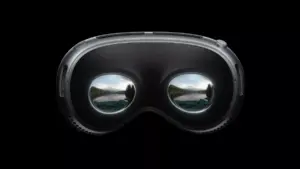
The Apple Vision Pro displays are leaps and bounds ahead of anything Meta offers so far. It features two Micro OLED 4K displays, one per eye.
Each display is the size of a postage stamp, which produces incredible pixel density. The two 4K displays combined have 23 million pixels, which Apple says is 64 times the pixel density of an iPhone. These 4K displays are also one of the big ways that the Apple Vision Pro beats the Meta Quest Pro.
Apple says that the twin displays feature “wide color and high dynamic range” though it’s unclear if that means the displays support HDR content in formats like HDR10 or Dolby Vision. And thanks to the new R1 chip developed by Apple, content will get to those displays in just 12ms.
If you need glasses though, we do have some bad news for you. Due to its design, the Apple Vision Pro will not work with glasses. Instead, Apple has collaborated with ZEISS for optical inserts to replace your glasses while using the headset. It is unclear what these inserts will cost or if they impact the visual fidelity of the headset in any way, though Apple says they will ensure the headset works as intended.
Apple Vision Pro apps and visionOS

Apple Vision Pro wasn’t the only new product introduced by Apple at WWDC. It also introduced visionOS, a brand new operating system specifically designed for the Vision Pro. It allows developers to build apps natively for the mixed reality headset and introduces some new features as well.
The biggest new feature? EyeSight. We’ve talked about it already, but EyeSight could either be the coolest thing or the creepiest thing about the Vision Pro headset. It displays your eyes to the world around you or hides them if you’re immersed in the headset. If you are immersed in a particular app or workflow, EyeSight also will bring you slowly out of that immersion and into the physical world when someone enters your direct field of view. As that person fades into the twin 4K displays, your eyes will simultaneously fade in on the front display of the Vision Pro.
The Vision Pro is all about staying in the physical space as much as possible, even if you can turn the crown on the top of the headset to make yourself more immersed in the virtual world. And visionOS works on the assumption of coexisting with your physical space. It creates a 3D user interface that responds to natural light and casts shadows and allows for apps to be expanded and moved with just a hand gesture.
Speaking of apps, the Apple Vision Pro should come with a surprising amount out of the box. While native visionOS apps are still relatively few and far between, the mixed reality headset works with iOS and iPad OS apps as well to provide you with a ton of options all in one App Store.
Apple showed off a few examples of how these apps operate on the Vision Pro. Photos can be viewed in a massive display right in front of you or in a panoramic view. The Mindfulness app expands into a full-room experience for some meditative bliss. And you can watch movies and shows through Apple TV Plus and Disney Plus on a massive theatre-sized screen.
The Vision Pro may not be aimed at playing the best VR games, but that doesn’t mean you can’t game with it. Apple Arcade provides over 100 games — including NBA 2K — that will be playable on day one. And you can even use a Bluetooth controller to play your games since the Apple Vision Pro has no first-party controllers.

Typical productivity apps that you use on your other Apple devices are available on the Vision Pro too. Safari is viewable in a massive display and you can expand it to see all your open tabs at once. FaceTime is there too, and you can move people’s video feeds to one side of your display while keeping other apps in view.
You, however, won’t be visible in FaceTime. At least, not the real version of you. Instead, the Apple Vision Pro will create a Digital Persona to represent you in FaceTime that will simulate your face and hand movements.
But the biggest productivity upgrade? You can expand your Mac display into a larger 4K display just by looking at a compatible machines. This wirelessly beams the Mac’s display to your headset, letting you view things in the same view as other visionOS apps.
With this in mind the Vision Pro is compatible with Bluetooth devices like the Magic Keyboard or Magic Trackpad, though it does have onboard tools to handle productivity — including voice and sight, and a virtual keyboard.
Apple VR/AR mixed reality headset rumored specs
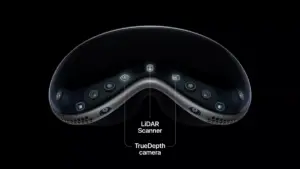
We don’t know the full spec sheet for the Apple Vision Pro yet, but Apple did confirm some key details.
First, let’s take a look at the outside of the headset. The headset features 12 cameras, six microphones and five sensors to allow for eye tracking, hand tracking and voice commands to be all you need to control the device. Then inside the headset is a ring of LED lights that project invisible patterns onto your eyes to assist with the eye-tracking. These LED lights also power Optic ID, which is the Vision Pro’s version of Face ID.
Under the hood, the Vision Pro is powered entirely by Apple silicon. An M2 chip does most of the heavy lifting, but a brand-new R1 chip handles the sensor inputs and ensures the display doesn’t lag behind. Apple says the R1 chip keeps the input lag of the twin 4K Micro OLED displays at just around 12ms — on par with a lot of the best TVs.
Finally, Apple promises spatial audio thanks to a speaker on each side of the headset, near where it connects with your Head Band. These speakers — or audio pods — provide what Apple calls “the most advanced Spatial Audio system ever.” The individually amplified drivers inside each audio pod can even be fine-tuned to deliver Personalized Spatial Audio based on your head and ears.
Apple Vision Pro battery
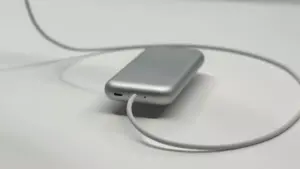
Here’s arguably the biggest knock against the Apple Vision Pro, aside from the other-worldly price tag. While headsets like the Meta Quest 3 are true standalone headsets that can also tether to a PC, the Vision Pro needs to be attached to something to work.
Now thankfully, you do have options. Option one, you can plug in the headset and use the Vision Pro all day long. Unfortunately, Apple didn’t say if that works if the headset is plugged into a Mac or MacBook, so the assumption is you’ll need to plug straight into the nearest wall.
If that doesn’t appeal to you though, there is an alternative. Apple has designed an external battery pack that connects around the temple of the headset via a woven cable.
The good news? The battery is slim enough to fit in your pocket, at least according to Apple. The bad news? It only lasts for two hours and does seem to be a proprietary charger. Oh, and you may need to buy it separately, which would add to the Apple Vision Pro’s $3,499 price tag.
Apple Vision Pro controls
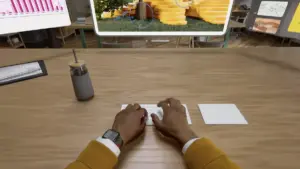
While the battery may be one of the lamer aspects of Apple’s first headset, the controls are not. That’s because Apple ditches controllers entirely with the Apple Vision Pro, instead using the headset’s many sensors and cameras to allow you to control the device using just your eyes, hands and voice.
And these intuitive controls are meant to feel natural as well. Apple says all it takes is turning your head to shift the focus of the display, or a simple tap of your fingers to simulate a mouse click. You can even keep your hands in a natural position rather than holding them in front of you when making gestures. Glancing at a search bar and speaking will even allow you to type into the search bar for easy use.
Aside from these new methods of controlling the mixed reality headset, there are two familiar features. First, Siri is back, giving you Apple’s famous voice assistant right out of the box. Second, the headset does work with a range of Bluetooth products. In addition to supporting controllers like the PS5 DualSense, it also supports the Apple Magic Keyboard, Mouse and Trackpad in case you don’t want to rely on hand gestures or a virtual keyboard.
Apple Vision Pro vs Apple Glass
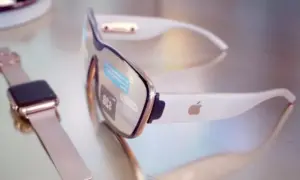
According to reports, the Apple VR/AR mixed reality headset — which we now know as the Apple Vision Pro — was designed to be a precursor to Apple Glass.
And now that we’ve officially seen the Vision Pro, it’s clear that Apple wanted to have a true mixed reality device rather than a VR headset. The Vision Pro at times feels like an AR glasses copycat, particularly with features such as EyeSight that allow others to see your eyes while you’re using the Vision Pro.
Based on everything we’ve heard, Apple wants the Apple Glass to look and act like an ordinary lightweight pair of glasses rather than adopt the Vision Pro’s approach. That means glasses that are able to project information, and presumably imagery, onto the lenses. Unfortunately, Apple Glasses may not arrive for a long time, with Apple reportedly delaying the project due to technical challenges.
Still not sure what the difference between mixed reality, augmented reality and virtual reality actually is? We have an explainer that tells you exactly what mixed reality is and what Microsoft, Meta and Apple have planned for it.
Apple Vision Pro vs Meta Quest 3

Both Apple and Meta have announced new headsets touting mixed reality features, but the two headsets are definitely different. Granted, that should be expected when the Apple Vision Pro is nearly seven times the price of the Meta Quest 3, but it’s more than that. Both headsets tackle the issue of experiencing mixed reality in notably different ways, and each makes a case for being the better headset for most people. Check out our Apple Vision Pro versus Meta Quest 3 face-off for the full breakdown.
Apple Vision Pro vs Meta Quest Pro
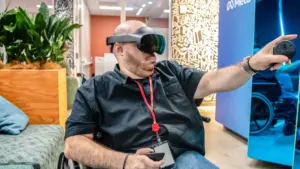
The Meta Quest 3 isn’t the only Meta headset that Apple has to contend with. The Meta Quest Pro is also a mixed reality headset, with a more professional user base that will definitely be interested in the Apple Vision Pro as an alternative.
And unfortunately for the Quest Pro, the Apple headset is the clear winner between the two — as long as you can stomach the $2,499 price difference. We found seven ways Apple Vision Pro beats the Meta Quest Pro, from superior specs to a better software ecosystem for productivity.
